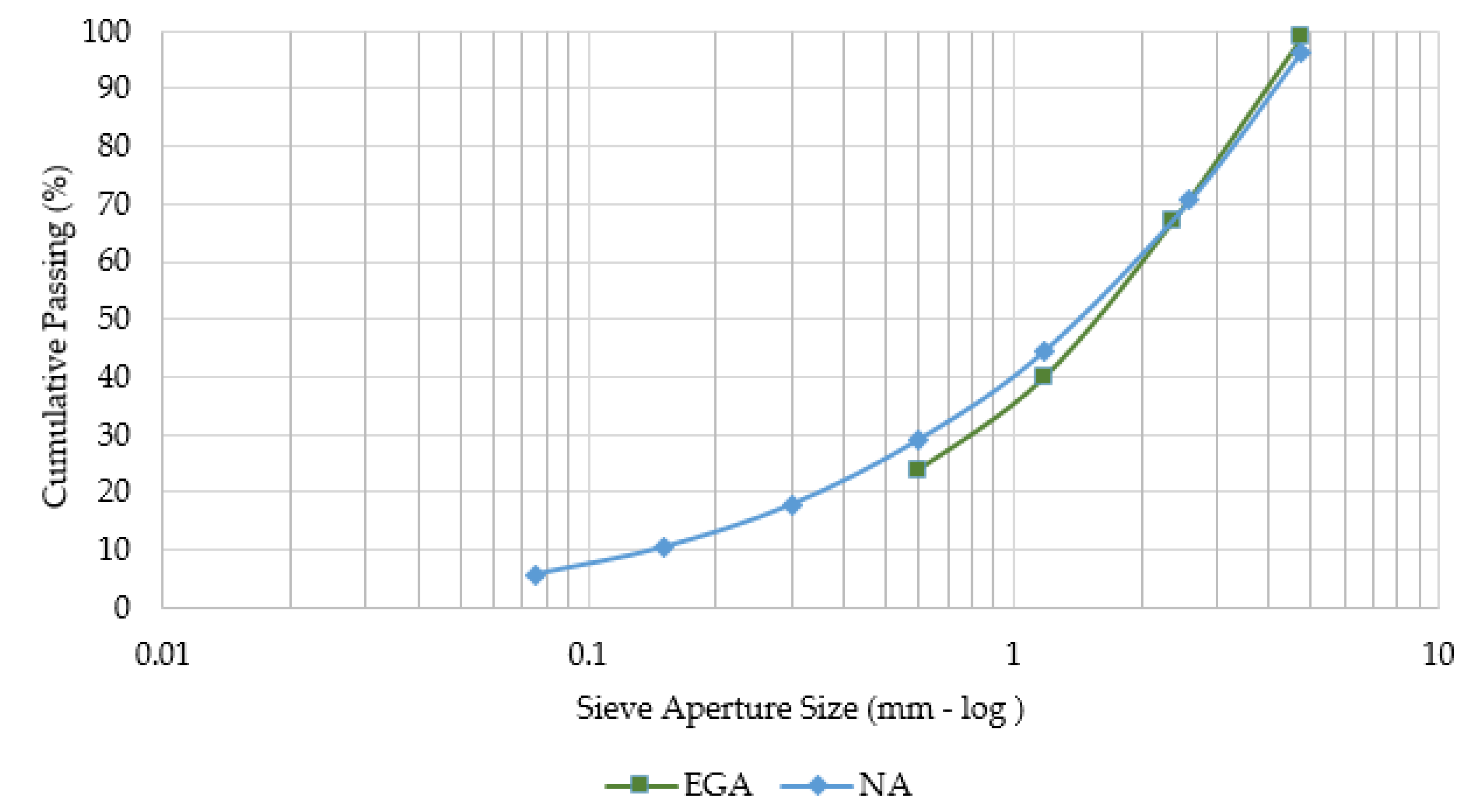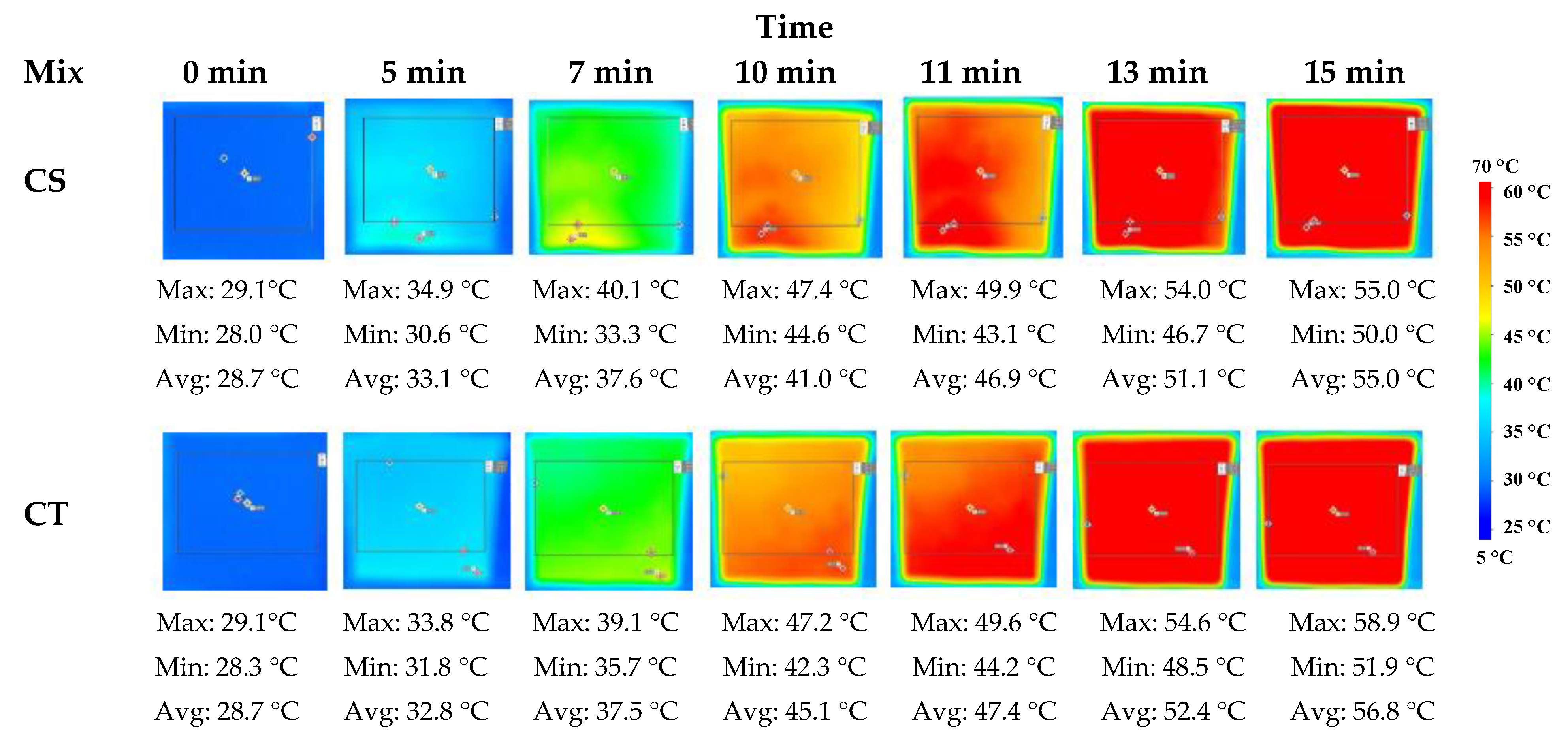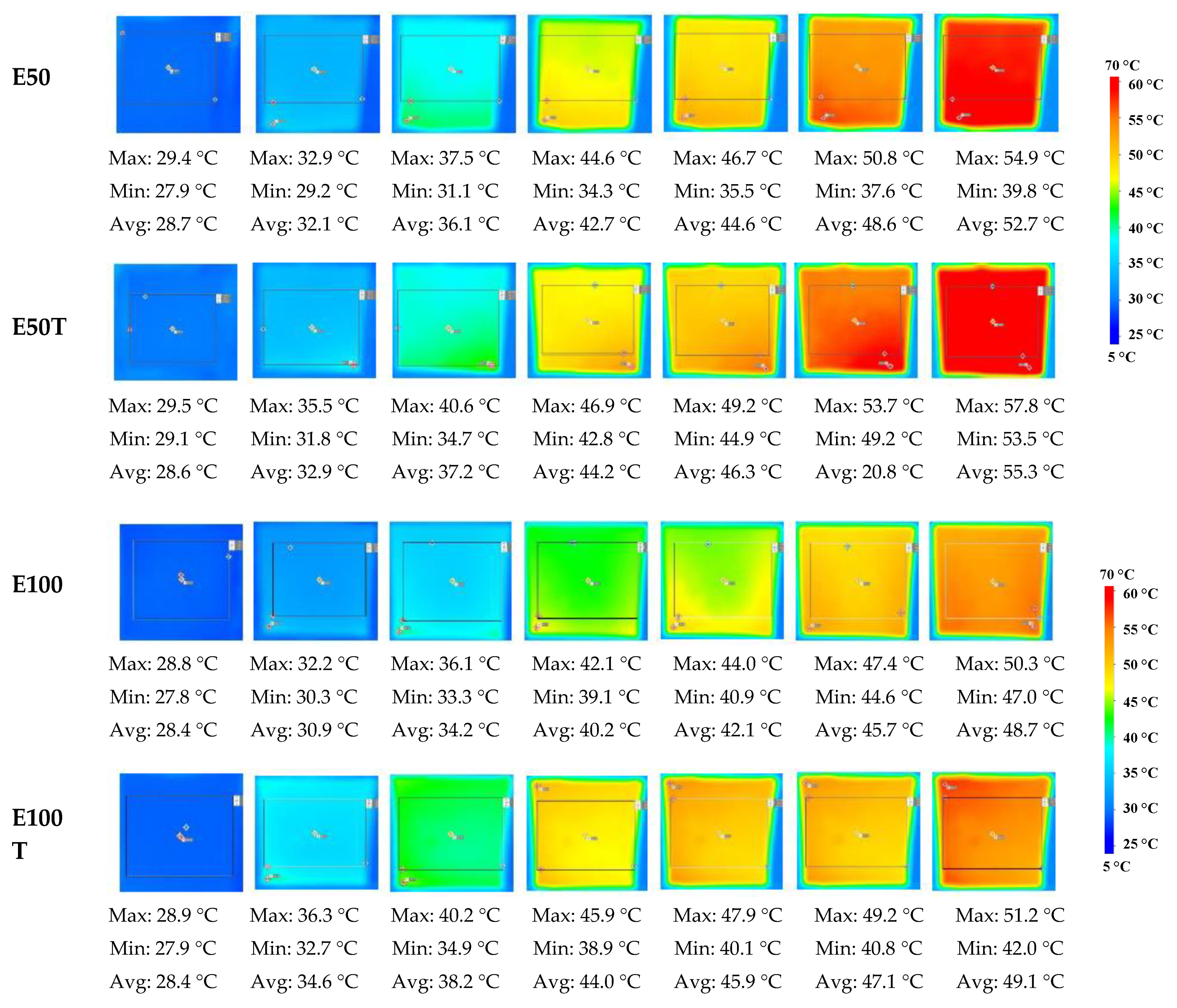Thermal and Mechanical Properties of Cement Mortar Composite Containing Recycled Expanded Glass Aggregate and Nano Titanium Dioxide
Abstract
:1. Introduction
2. Materials and Methods
2.1. Materials
2.2. Sample Preparation
2.3. Experimental Tests
3. Results and Discussion
3.1. Workability
3.2. Density
3.3. Water Absorption
3.4. Compressive Strength
3.5. Infrared Thermography
4. Conclusions
Author Contributions
Funding
Acknowledgments
Conflicts of Interest
References
- Chung, O.; Jeong, S.G.; Kim, S. Preparation of energy efficient paraffinic PCMs/expanded vermiculite and perlite composites for energy saving in buildings. Sol. Energy Mater. Sol. Cells 2015, 137, 107–112. [Google Scholar] [CrossRef]
- Rao, V.V.; Parameshwaran, R.; Ram, V.V. PCM-mortar based construction materials for energy efficient buildings: A review on research trends. Energy Build. 2018, 158, 95–122. [Google Scholar] [CrossRef]
- Krishnamoorthy, R.R.; Zujip, J.A. Thermal conductivity and microstructure of concrete using recycle glass as a fine aggregate replacement. Int. J. Emerg. Technol. Adv. Eng. 2013, 3, 463–471. [Google Scholar]
- Real, S.; Gomes, M.G.; Moret Rodrigues, A.; Bogas, J.A. Contribution of structural lightweight aggregate concrete to the reduction of thermal bridging effect in buildings. Constr. Build. Mater. 2016, 121, 460–470. [Google Scholar] [CrossRef]
- Roberz, F.; Loonen, R.C.G.M.; Hoes, P.; Hensen, J.L.M. Ultra-lightweight concrete: Energy and comfort performance evaluation in relation to buildings with low and high thermal mass. Energy Build. 2017, 138, 432–442. [Google Scholar] [CrossRef]
- Sibahy, A.A.; Edwards, R. Thermal behaviour of novel lightweigh concrete at ambient and elevated temperatures: Experimental, modelling and parametric studies. Constr. Build. Mater. 2012, 31, 174–187. [Google Scholar] [CrossRef]
- Al-Zubaid, A.B.; Shabeeb, K.M.; Ali, A.I. Study the effect of recycled glass on the mechanical properties of green concrete. Energy Procedia 2017, 119, 680–692. [Google Scholar] [CrossRef]
- Park, S.B.; Lee, B.C.; Kim, J.H. Studies on mechanical properties of concrete containing waste glass aggregate. Cem. Concr. Res. 2004, 34, 2181–2189. [Google Scholar] [CrossRef]
- Islam, G.M.S.; Rahman, M.H.; Kazi, N. Waste glass powder as partial replacement of cement for sustainable concrete practice. Int. J. Sustain. Built Environ. 2017, 6, 37–44. [Google Scholar] [CrossRef] [Green Version]
- Aliabdo, A.A.; Abd Elmoaty, A.E.M.; Aboshama, A.Y. Utilization of waste glass powder in the production of cement and concrete. Constr. Build. Mater. 2016, 124, 866–877. [Google Scholar] [CrossRef]
- Afshinnia, K.; Rangaraju, P.R. Efficiency of ternary blends containing fine glass powder in mitigating alkali–silica reaction. Constr. Build. Mater. 2015, 100, 234–245. [Google Scholar] [CrossRef]
- Yun, T.S.; Jeong, Y.J.; Han, T.S.; Youm, K.S. Evaluation of thermal conductivity for thermally insulated concretes. Energy Build. 2013, 61, 125–132. [Google Scholar] [CrossRef]
- Chung, S.Y.; Abd Elrahman, M.; Sikora, P.; Rucinska, T.; Horszczaruk, E.; Stephan, D. Evaluation of the effects of crushed and expanded waste glass aggregates on the material properties of lightweight concrete using image-based approaches. Materials 2017, 10, 1354. [Google Scholar] [CrossRef] [Green Version]
- Chung, S.Y.; Han, T.S.; Kim, S.Y.; Kim, J.H.J.; Youm, K.S.; Lim, J.H. Evaluation of effect of glass beads on thermal conductivity of insulating concrete using micro CT images and probability functions. Cem. Concr. Compos. 2016, 65, 150–162. [Google Scholar] [CrossRef]
- Ez-zaki, H.; El Gharbi, B.; Diouri, A. Development of eco-friendly mortars incorporating glass and shell powders. Constr. Build. Mater. 2018, 159, 198–204. [Google Scholar] [CrossRef]
- Abd Elrahman, M.; Chung, S.Y.; Stephan, D. Effect of different expanded aggregates on the properties of lightweight concrete. Mag. Concr. Res. 2018, 71, 95–107. [Google Scholar] [CrossRef]
- Yu, Q.L.; Spiesz, P.; Brouwers, H.J.H. Ultra-lightweight concrete: Conceptual design and performance evaluation. Cem. Concr. Compos. 2015, 61, 18–28. [Google Scholar] [CrossRef]
- Yu, R.; van Onna, D.V.; Spiesz, P.; Yu, Q.L.; Brouwers, H.J.H. Development of ultra-lightweight fibre reinforced concrete applying expanded waste glass. J. Clean. Prod. 2016, 112, 690–701. [Google Scholar] [CrossRef]
- Šeputytė-Jucikė, J.; Sinica, M. The effect of expanded glass and polystyrene waste on the properties of lightweight aggregate concrete. Eng. Struct. Technol. 2016, 8, 31–40. [Google Scholar] [CrossRef] [Green Version]
- Maddalena, C.; Luca, B. Durability of lightweight concrete with expanded glass and silica fume. Mater. J. 2017, 114. [Google Scholar] [CrossRef] [Green Version]
- Rumsys, D.; Spudulis, E.; Bacinskas, D.; Kaklauskas, G. Compressive strength and durability properties of structural lightweight concrete with fine expanded glass and/or clay aggregates. Materials 2018, 11, 2434. [Google Scholar] [CrossRef] [PubMed] [Green Version]
- Bogas, J.A.; Gomes, A.; Pereira, M. Self-compacting lightweight concrete produced with expanded clay aggregate. Constr. Build. Mater. 2012, 35, 1013–1022. [Google Scholar] [CrossRef]
- Yu, Q.; Spiesz, P.; Brouwers, H. Development of cement-based lightweight composites–Part 1: Mix design methodology and hardened properties. Cem. Concr. Compos. 2013, 44, 17–29. [Google Scholar] [CrossRef] [Green Version]
- Spiesz, P.; Yu, Q.; Brouwers, H. Development of cement-based lightweight composites–Part 2: Durability-related properties. Cem. Concr. Compos. 2013, 44, 30–40. [Google Scholar] [CrossRef] [Green Version]
- Namsone, E.; Sahmenko, G.; Namsone, E.; Korjakins, A. Thermal conductivity and frost resistance of foamed concrete with porous aggregate, Environment. Technology. Resources. In Proceedings of the 11th International Scientific and Practical Conference, Rezekne, Latvia, 15–17 June 2017; Volume 3, pp. 222–228. [Google Scholar]
- Kurpińska, M.; Ferenc, T. Effect of porosity on physical properties of lightweight cement composite with foamed glass aggregate. In Proceedings of the II International Conference of Computational Methods in Engineering Science (CMES’2017), Lublin, Poland, 23–25 November 2017; p. 06005. [Google Scholar]
- Kurpinska, M.; Kułak, L. Predicting performance of lightweight concrete with granulated expanded Glass and Ash aggregate by means of using Artificial Neural Networks. Materials 2019, 12, 2002. [Google Scholar] [CrossRef] [Green Version]
- Lee, G.; Poon, C.S.; Wong, Y.L.; Ling, T.C. Effects of recycled fine glass aggregates on the properties of dry–mixed concrete blocks. Constr. Build. Mater. 2013, 38, 638–643. [Google Scholar] [CrossRef]
- Penacho, P.; Brito, J.D.; Rosário Veiga, M. Physico-mechanical and performance characterization of mortars incorporating fine glass waste aggregate. Cem. Concr. Compos. 2014, 50, 47–59. [Google Scholar] [CrossRef]
- Lucas, S.S.; Ferreira, V.M.; de Aguiar, J.L.B. Incorporation of titanium dioxide nanoparticles in mortars—Influence of microstructure in the hardened state properties and photocatalytic activity. Cem. Concr. Res. 2013, 43, 112–120. [Google Scholar] [CrossRef] [Green Version]
- Behfarnia, K.; Azarkeivan, A.; Keivan, A. The effects of TiO2 and ZnO nanoparticles on physical and mechanical properties of normal concrete. Asian J. Civ. Eng. (Bhrc) 2013, 14, 517–531. [Google Scholar]
- Ma, B.; Li, H.; Mei, J.; Li, X.; Chen, F. Effects of nano-TiO2 on the toughness and durability of cement-based material. Adv. Mater. Sci. Eng. 2015, 2015, 583106. [Google Scholar] [CrossRef] [Green Version]
- Sorathiya, J.; Shah, S.; Kacha, M.S. Effect on addition of nano “titanium dioxide”(TiO2) on compressive strength of cementitious concrete. Kalpa Publ. Civ. Eng. 2017, 1, 219–225. [Google Scholar]
- Khushwaha, A.; Saxena, R.; Pal, S. Effect of titanium dioxide on the compressive strength of concrete. J. Civ. Eng. Environ. Technol. 2015, 2, 482–486. [Google Scholar]
- Grebenisan, E.; Hegyi, A.; Szilágyi, H. A review on developing self-cleaning cementitious materials. Constructii 2018, 19, 37–43. [Google Scholar]
- Nazari, A.; Riahi, S.; Riahi, S.; Shamekhi, S.F.; Khademno, A. Assessment of the effects of the cement paste composite in presence TiO2 nanoparticles. J. Am. Sci. 2010, 6, 43–46. [Google Scholar]
- Nazari, A.; Riahi, S. TiO2 nanoparticles’ effects on properties of concrete using ground granulated blast furnace slag as binder. Sci. China Technol. Sci. 2011, 54, 3109. [Google Scholar] [CrossRef]
- Cui, H.; Feng, T.; Yang, H.; Bao, X.; Tang, W.; Fu, J. Experimental study of carbon fiber reinforced alkali-activated slag composites with micro-encapsulated PCM for energy storage. Constr. Build. Mater. 2018, 161, 442–451. [Google Scholar] [CrossRef]
- Yousefi, A.; Bunnori, N.M.; Khavarian, M.; Hassanshahi, O.; Majid, T.A. Experimental investigation on effect of multi-walled carbon nanotubes concentration on flexural properties and microstructure of cement mortar composite. In Proceedings of the International Conference of Global Network for Innovative Technology (IGNITE) and AWAM International Conference in Civil Engineering (AICCE) 2017, Penang, Malaysia, 8–10 August 2017; AIP Conference Proceedings. AIP Publishing: Melville, NY, USA, 2017; p. 020032. [Google Scholar] [CrossRef]
- Ling, T.C.; Poon, C.S.; Kou, S.C. Influence of recycled glass content and curing conditions on the properties of self-compacting concrete after exposure to elevated temperatures. Cem. Concr. Compos. 2012, 34, 265–272. [Google Scholar] [CrossRef]
- Sharifi, Y.; Houshiar, M.; Aghebati, B. Recycled glass replacement as fine aggregate in self-compacting concrete. Front. Struct. Civ. Eng. 2013, 7, 419–428. [Google Scholar] [CrossRef]
- Wright, J.R.; Cartwright, C.; Fura, D.; Rajabipour, F. Fresh and hardened properties of concrete incorporating recycled glass as 100% sand replacement. J. Mater. Civ. Eng. 2013, 26, 04014073. [Google Scholar] [CrossRef]
- Medina, C.; Zhu, W.; Howind, T.; de Rojas, M.I.S.; Frías, M. Influence of mixed recycled aggregate on the physical–mechanical properties of recycled concrete. J. Clean. Prod. 2014, 68, 216–225. [Google Scholar] [CrossRef]
- Borhan, M.; Mohamed Sutan, N. Laboratory study of water absorption of modified mortar. Unimas E J. Civ. Eng. 2011, 2, 25–30. [Google Scholar]
- Qudoos, A.; Kim, H.; Ryou, J.S. Influence of titanium dioxide nanoparticles on the sulfate attack upon ordinary Portland cement and slag-blended mortars. Materials 2018, 11, 356. [Google Scholar]
- Nazari, A.; Riahi, S. The effect of TiO2 nanoparticles on water permeability and thermal and mechanical properties of high strength self-compacting concrete. Mater. Sci. Eng. A 2010, 528, 756–763. [Google Scholar] [CrossRef]
- Nehdi, M.; Soliman, A.M. Early-age properties of concrete: Overview of fundamental concepts and state-of-the-art research. Proc. Inst. Civ. Eng. Constr. Mater. 2011, 164, 57–77. [Google Scholar] [CrossRef]
- Lee, B.Y.; Jayapalan, A.R.; Kurtis, K.E. Effects of nano-TiO2 on properties of cement-based materials. Mag. Concr. Res. 2013, 65, 1293–1302. [Google Scholar] [CrossRef]











| Property | Grain Size | |||
|---|---|---|---|---|
| 0.25–0.5 | 0.5–1 | 1–2 | 2–4 | |
| Loose bulk density (kg/m3) | 300 | 250 | 220 | 190 |
| Particle density (kg/m3) | 540 | 450 | 350 | 310 |
| Compressive strength (MPa) | ≥2.9 | ≥2.6 | ≥2.4 | ≥2.2 |
| Thermal conductivity (W/mK) | 0.07 | 0.07 | 0.07 | 0.07 |
| Properties | Value |
|---|---|
| Purity | 99.98% |
| Average Particles Size | 30 (nm) |
| Specific surface area | 50 (m2/g) |
| Bulk Density | 0.42 (g/cm3) |
| True Density | 3.9 g/cm3) |
| PH | 5.5–6.5 |
| Composite ID | NA | EGA | Cement | Water | S.P | nTiO2 |
|---|---|---|---|---|---|---|
| CS | 1750 | 0 | 525 | 233 | 11.7 | - |
| CT | 1750 | 0 | 525 | 233 | 11.7 | 1% |
| E50 | 875 | 133 | 525 | 233 | 8.8 | - |
| E50T | 875 | 133 | 525 | 233 | 8.8 | 1% |
| E100 | 0 | 267 | 525 | 233 | 5.8 | - |
| E100T | 0 | 267 | 525 | 233 | 5.8 | 1% |
| Mix ID | Average Flow Diameter (mm) |
|---|---|
| CS | 140.0 |
| E50 | 177.3 |
| E100 | 201.3 |
| CT | 147.5 |
| E50T | 182.5 |
| E100T | 215.3 |
| Mix | Δ (Tave.) | Heat Transfer Rate (°C/min) | ||||
|---|---|---|---|---|---|---|
| 5 min | 10 min | 15 min | 5 min | 10 min | 15 min | |
| CS | 4.40 | 12.30 | 26.30 | 1.58 | 2.80 | 1.75 |
| CT | 4.10 | 16.40 | 28.10 | 2.46 | 2.34 | 1.87 |
| E50 | 3.40 | 14.00 | 24.00 | 2.12 | 2.00 | 1.60 |
| E50T | 4.30 | 15.60 | 26.40 | 2.26 | 2.16 | 1.76 |
| E100 | 2.50 | 11.80 | 20.30 | 1.86 | 1.70 | 1.35 |
| E100T | 6.20 | 15.60 | 20.70 | 1.88 | 1.02 | 1.38 |
© 2020 by the authors. Licensee MDPI, Basel, Switzerland. This article is an open access article distributed under the terms and conditions of the Creative Commons Attribution (CC BY) license (http://creativecommons.org/licenses/by/4.0/).
Share and Cite
Yousefi, A.; Tang, W.; Khavarian, M.; Fang, C.; Wang, S. Thermal and Mechanical Properties of Cement Mortar Composite Containing Recycled Expanded Glass Aggregate and Nano Titanium Dioxide. Appl. Sci. 2020, 10, 2246. https://doi.org/10.3390/app10072246
Yousefi A, Tang W, Khavarian M, Fang C, Wang S. Thermal and Mechanical Properties of Cement Mortar Composite Containing Recycled Expanded Glass Aggregate and Nano Titanium Dioxide. Applied Sciences. 2020; 10(7):2246. https://doi.org/10.3390/app10072246
Chicago/Turabian StyleYousefi, Ali, Waiching Tang, Mehrnoush Khavarian, Cheng Fang, and Shanyong Wang. 2020. "Thermal and Mechanical Properties of Cement Mortar Composite Containing Recycled Expanded Glass Aggregate and Nano Titanium Dioxide" Applied Sciences 10, no. 7: 2246. https://doi.org/10.3390/app10072246





